2019四级翻译新题型模拟练习及答案:中国园林视角
- 格式:docx
- 大小:36.98 KB
- 文档页数:1

四六级翻译答案(第四期)牛刀小试1.施比得更重要。
2.要想拥有健康的身体,必须养成良好的饮食习惯。
3.想要学好英语,你必须付出巨大的努力。
4.为了使园林风格独特,园林的主人通常会请一些文人画家参与园林的设计。
参考译文1.To give is much more important than to receive.2.The most important thing for one’s health is to keep a good eating habit.3.To learn English well,you must make great effort.4.To acquire a distinctive feature and style,the owner of the garden usually invites someliterati-painters to participate in the designing.段落翻译1中国古典园林在中国传统艺术文化中独具一格。
2园林的修建是为了满足人们休闲和住宿的需求。
3中国古典园林包括皇家园林和私家园林。
4中国园林将人造景观与自然风光、建筑、绘画、文学、书法、园艺融于一体。
5在园林设计中,很重视人造景观和自然景观的和谐。
6人造景观的布局很重要,因为它决定了园林的风格,也展现了园林主人的性情。
参考译文Classical Chinese gardens are a special aspect in traditional Chinese culture and art.A garden is constructed to meet people’s demand for relaxation and lodging.Classical Chinese gardens include imperial gardens and private gardens.A Chinese garden mixes man-made landscape with natural scenery,architecture,painting,literature,calligraphy,and horticulture.Great importance has been attached to the harmony between man-made scenery and natural landscape in the designing of a garden.The layout of man-made scenery is important for it might determine the style of a garden and reveal the temperament of the owner.翻译要点评析1.本句的难点在“独具一格”的译法,对于类似成语,翻译时不必一一对应,关键是理解其核心含义“风格独到”,可译为be a special aspect in…;“中国古典园林”即classical Chinese gardens;“中国传统艺术文化”:traditional Chinese culture and art。
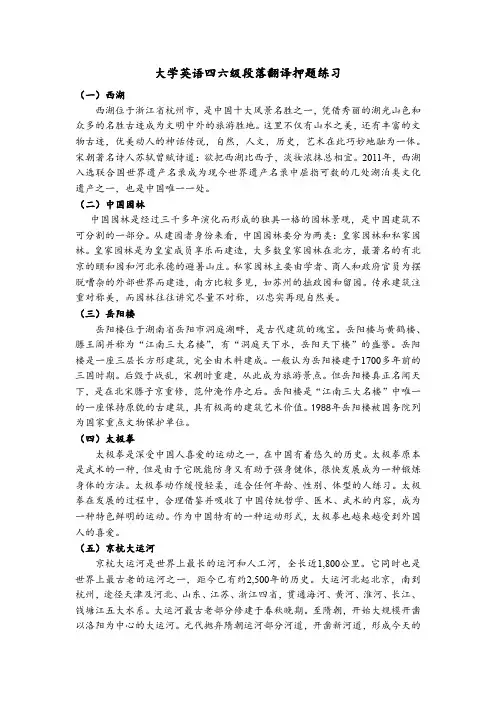
大学英语四六级段落翻译押题练习(一)西湖西湖位于浙江省杭州市,是中国十大风景名胜之一,凭借秀丽的湖光山色和众多的名胜古迹成为文明中外的旅游胜地。
这里不仅有山水之美,还有丰富的文物古迹,优美动人的神话传说,自然,人文,历史,艺术在此巧妙地融为一体。
宋朝著名诗人苏轼曾赋诗道:欲把西湖比西子,淡妆浓抹总相宜。
2011年,西湖入选联合国世界遗产名录成为现今世界遗产名录中屈指可数的几处湖泊类文化遗产之一,也是中国唯一一处。
(二)中国园林中国园林是经过三千多年演化而形成的独具一格的园林景观,是中国建筑不可分割的一部分。
从建园者身份来看,中国园林要分为两类:皇家园林和私家园林。
皇家园林是为皇室成员享乐而建造,大多数皇家园林在北方,最著名的有北京的颐和园和河北承德的避暑山庄。
私家园林主要由学者、商人和政府官员为摆脱嘈杂的外部世界而建造,南方比较多见,如苏州的拙政园和留园。
传承建筑注重对称美,而园林往往讲究尽量不对称,以忠实再现自然美。
(三)岳阳楼岳阳楼位于湖南省岳阳市洞庭湖畔,是古代建筑的瑰宝。
岳阳楼与黄鹤楼、滕王阁并称为“江南三大名楼”,有“洞庭天下水,岳阳天下楼”的盛誉。
岳阳楼是一座三层长方形建筑,完全由木料建成。
一般认为岳阳楼建于1700多年前的三国时期。
后毁于战乱,宋朝时重建,从此成为旅游景点。
但岳阳楼真正名闻天下,是在北宋滕子京重修,范仲淹作序之后。
岳阳楼是“江南三大名楼”中唯一的一座保持原貌的古建筑,具有极高的建筑艺术价值。
1988年岳阳楼被国务院列为国家重点文物保护单位。
(四)太极拳太极拳是深受中国人喜爱的运动之一,在中国有着悠久的历史。
太极拳原本是武术的一种,但是由于它既能防身又有助于强身健体,很快发展成为一种锻炼身体的方法。
太极拳动作缓慢轻柔,适合任何年龄、性别、体型的人练习。
太极拳在发展的过程中,合理借鉴并吸收了中国传统哲学、医术、武术的内容,成为一种特色鲜明的运动。
作为中国特有的一种运动形式,太极拳也越来越受到外国人的喜爱。
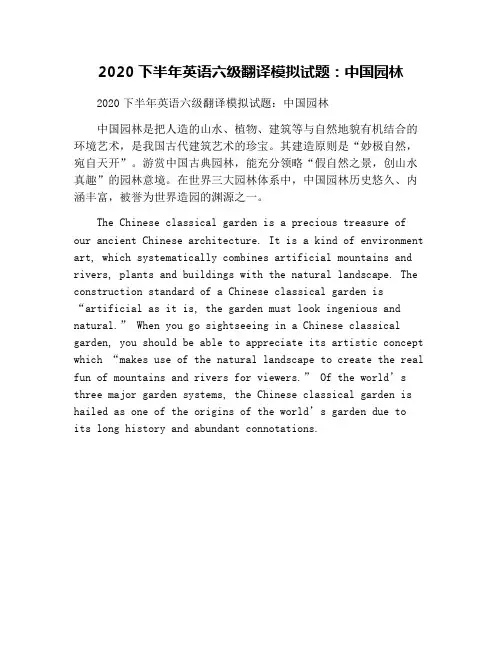
2020下半年英语六级翻译模拟试题:中国园林2020下半年英语六级翻译模拟试题:中国园林中国园林是把人造的山水、植物、建筑等与自然地貌有机结合的环境艺术,是我国古代建筑艺术的珍宝。
其建造原则是“妙极自然,宛自天开”。
游赏中国古典园林,能充分领略“假自然之景,创山水真趣”的园林意境。
在世界三大园林体系中,中国园林历史悠久、内涵丰富,被誉为世界造园的渊源之一。
The Chinese classical garden is a precious treasure of our ancient Chinese architecture. It is a kind of environment art, which systematically combines artificial mountains and rivers, plants and buildings with the natural landscape. The construction standard of a Chinese classical garden is “artificial as it is, the garden must look ingenious and natural.” When you go sightseeing in a Chinese classical garden, you should be able to appreciate its artistic concept which “makes use of the natural landscape to create the real fun of mountains and rivers for viewers.” Of the world’s three major garden systems, the Chinese classical garden is hailed as one of the origins of the world’s garden due toits long history and abundant connotations.。
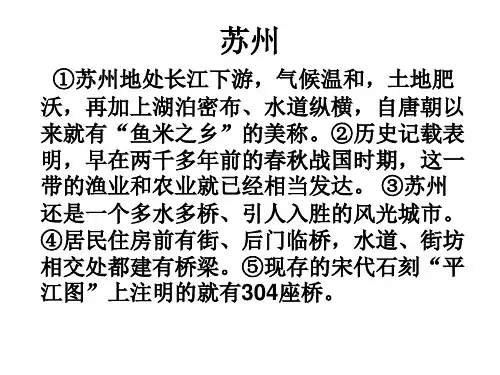
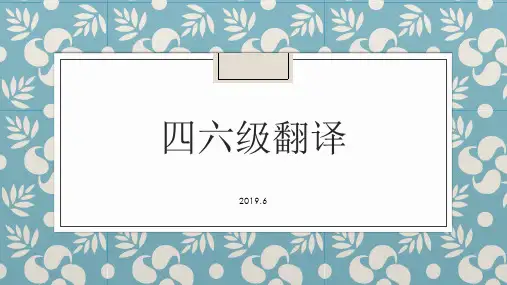

1 红包红包,又叫“压岁钱”,是用红色信封或纸包着钱的红纸包儿。
红包,通常是用于中国农历新年或喜庆时馈赠的礼金。
派:“红包”,是中国人过年的一种重要习俗。
中国人喜爱红色,因为红色象征吉祥与好运,所以, 红包总是用红色的信封或纸来包。
派红包或给压岁钱,是长辈们给未成年的晚辈。
据说,压岁钱可以袪邪压祟,因为“岁”与“祟”谐音,晚辈得到压岁钱,就可以平平安安地度过一生。
Hong-Bao or Red Packet is also known as "a packet of lucky money", or simply "lucky money". Hong-Bao usually refers to a gift of money offered during the Chinese Lunar New Year and other celebrations/Giving or offering a Hong-Bao has been a traditional custom during the Chinese lunar New Year. Chinese people love the colour red as it is seen to represent good luck. A Hong-Bao is therefore usually made of red paper. Hong-Baos are normally given by seniors to the younger generation. It is said that lucky money helps drive away evil, because year and evil spirit sound alike. This means youngsters can protect themselves through the year.2 北京北京是有着三千多年建城史和八百五十多年建都史的历史文化名城。

段落翻译一、对龙图腾的崇拜在中国大约已绵延了八千多年。
中国龙是古人将鱼、蛇、马、牛等动物与云雾、雷电等自然天象集合而成的一种神物。
中国龙的形成与中华民族的多元融合过程同步。
在中国人的心目中,龙具有振奋腾飞、开拓变化的寓意和团结凝聚的精神。
二、秧歌舞是中国汉族的一种民间传统舞蹈,通常在北方省份表演。
秧歌舞者通常穿上明亮多彩的表演服装,他们的表演动作有力迅速。
在农历春节、元宵节等节日期间,人们一旦听到锣鼓声,不管外面天气有多冷,他们都会蜂拥到街上看秧歌舞表演。
近年来,中国东北某些城市的老年人自发组织了了秧歌队,队员常年通过跳秧歌舞来保持健康,同事他们也乐在其中。
三、长城是人类创造的世界奇迹之一。
如果你到了中国却没去过长城,就想到了巴黎没有去看看菲尔铁塔,或者就像到了埃及没有去看金字塔一样。
人们常说:“不到长城非好汉。
”实际上,长城最初只是一些断断续续的城墙,直到秦朝统一中国后才将其连城长城。
然而,今天我们看到的长城——东起山海关,西至嘉峪关——大部分都是在明代修建的。
四、饺子是深受中国人民喜爱的传统食品。
相传为古代医圣张仲景发明。
饺子的制作是包括:1)擀皮、2)备馅、3)包馅水煮三个步骤。
其特点是皮薄馅嫩,味道鲜美,形状独特,百食不厌。
民间有“好吃不过饺子”的俗语。
中国人接亲待客、逢年过节都有包饺子吃的习俗,寓意吉利。
对崇尚亲情的中国人来说,“更岁交子”吃饺子,更是欢度除夕、辞旧迎新必不可少的内容。
五、针灸是中医学的重要组成部分。
按照中医的经络理论,针灸疗法主要是通过疏通经络、调和气血,来达到阴阳归于平衡,使脏腑趋于调和之目的。
其特点是“内病外治”。
主要疗法是用针刺入病人身体的一定穴位,或用艾火的温热刺激烧灼病人的穴位,以达到刺激经络。
治疗病痛的目的。
针灸以其独特的优势,流传至今并传播到了世界,与中餐、功夫、中药一起被海外誉为中国的“新四大国粹”。
六、中国功夫即中国武术,是将技击寓于搏斗和套路运动之中的中国传统体育项目,承载着丰富的中国民族传统文化。
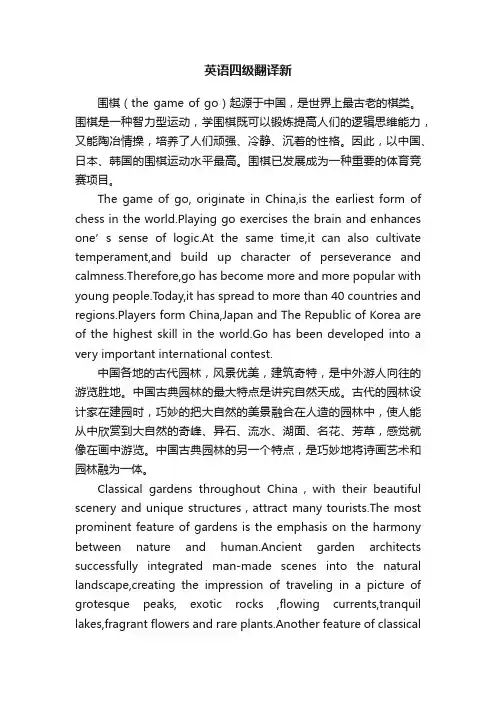
英语四级翻译新围棋(the game of go)起源于中国,是世界上最古老的棋类。
围棋是一种智力型运动,学围棋既可以锻炼提高人们的逻辑思维能力,又能陶冶情操,培养了人们顽强、冷静、沉着的性格。
因此,以中国、日本、韩国的围棋运动水平最高。
围棋已发展成为一种重要的体育竞赛项目。
The game of go, originate in China,is the earliest form of chess in the world.Playing go exercises the brain and enhances one’s sense of logic.At the same time,it can also cultivate temperament,and build up character of perseverance and calmness.Therefore,go has become more and more popular with young people.T oday,it has spread to more than 40 countries and regions.Players form China,Japan and The Republic of Korea are of the highest skill in the world.Go has been developed into a very important international contest.中国各地的古代园林,风景优美,建筑奇特,是中外游人向往的游览胜地。
中国古典园林的最大特点是讲究自然天成。
古代的园林设计家在建园时,巧妙的把大自然的美景融合在人造的园林中,使人能从中欣赏到大自然的奇峰、异石、流水、湖面、名花、芳草,感觉就像在画中游览。
中国古典园林的另一个特点,是巧妙地将诗画艺术和园林融为一体。
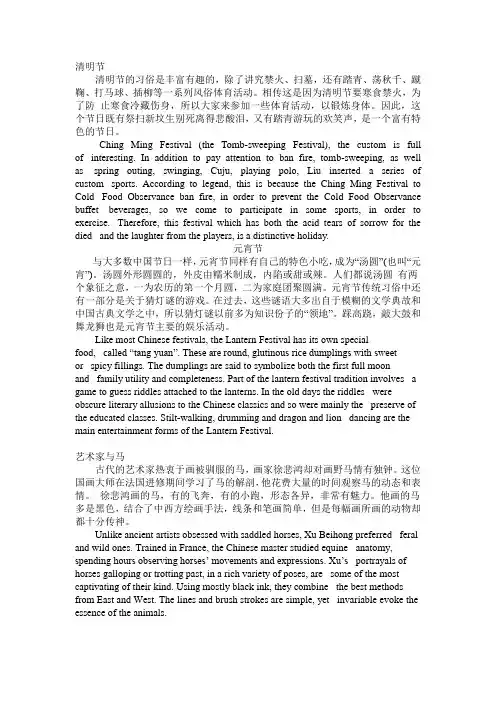
清明节清明节的习俗是丰富有趣的,除了讲究禁火、扫墓,还有踏青、荡秋千、蹴鞠、打马球、插柳等一系列风俗体育活动。
相传这是因为清明节要寒食禁火,为了防止寒食冷藏伤身,所以大家来参加一些体育活动,以锻炼身体。
因此,这个节日既有祭扫新坟生别死离得悲酸泪,又有踏青游玩的欢笑声,是一个富有特色的节日。
Ching Ming Festival (the Tomb-sweeping Festival), the custom is full of interesting. In addition to pay attention to ban fire, tomb-sweeping, as well as spring outing, swinging, Cuju, playing polo, Liu inserted a series of custom sports. According to legend, this is because the Ching Ming Festival to Cold Food Observance ban fire, in order to prevent the Cold Food Observance buffet beverages, so we come to participate in some sports, in order to exercise. Therefore, this festival which has both the acid tears of sorrow for the died and the laughter from the players, is a distinctive holiday.元宵节与大多数中国节日一样,元宵节同样有自己的特色小吃,成为“汤圆”(也叫“元宵”)。
汤圆外形圆圆的,外皮由糯米制成,内陷或甜或辣。
人们都说汤圆有两个象征之意,一为农历的第一个月圆,二为家庭团聚圆满。
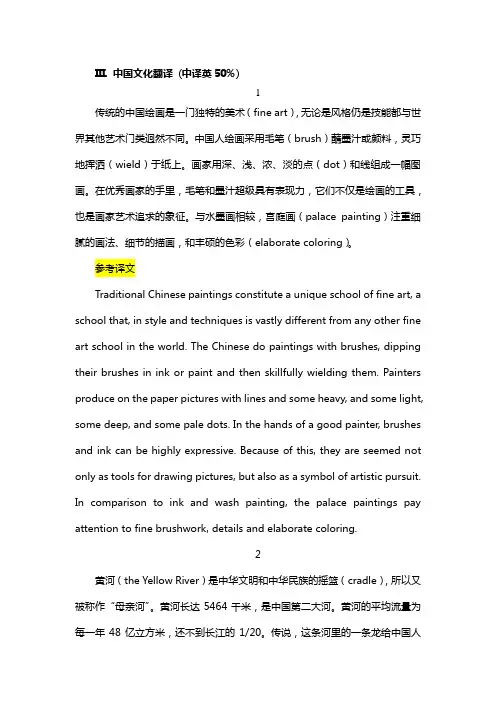
III. 中国文化翻译(中译英50%)1传统的中国绘画是一门独特的美术(fine art),无论是风格仍是技能都与世界其他艺术门类迥然不同。
中国人绘画采用毛笔(brush)蘸墨汁或颜料,灵巧地挥洒(wield)于纸上。
画家用深、浅、浓、淡的点(dot)和线组成一幅图画。
在优秀画家的手里,毛笔和墨汁超级具有表现力,它们不仅是绘画的工具,也是画家艺术追求的象征。
与水墨画相较,宫庭画(palace painting)注重细腻的画法、细节的描画,和丰硕的色彩(elaborate coloring)。
参考译文Traditional Chinese paintings constitute a unique school of fine art, a school that, in style and techniques is vastly different from any other fine art school in the world. The Chinese do paintings with brushes, dipping their brushes in ink or paint and then skillfully wielding them. Painters produce on the paper pictures with lines and some heavy, and some light, some deep, and some pale dots. In the hands of a good painter, brushes and ink can be highly expressive. Because of this, they are seemed not only as tools for drawing pictures, but also as a symbol of artistic pursuit. In comparison to ink and wash painting, the palace paintings pay attention to fine brushwork, details and elaborate coloring.2黄河(the Yellow River)是中华文明和中华民族的摇篮(cradle),所以又被称作“母亲河”。
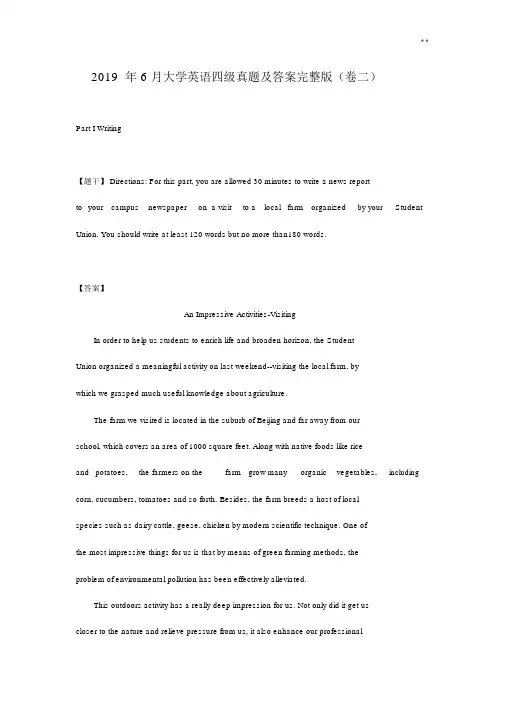
* * 2019 年 6 月大学英语四级真题及答案完整版(卷二)Part I Writing【题干】 Directions: For this part, you are allowed 30 minutes to write a news reportto your campus newspaper on a visit to a local farm organized by your Student Union. You should write at least 120 words but no more than180 words.【答案】An Impressive Activities-VisitingIn order to help us students to enrich life and broaden horizon, the StudentUnion organized a meaningful activity on last weekend--visiting the local farm, bywhich we grasped much useful knowledge about agriculture.The farm we visited is located in the suburb of Beijing and far away from ourschool, which covers an area of 1000 square feet. Along with native foods like riceand potatoes, the farmers on the farm grow many organic vegetables,including corn, cucumbers, tomatoes and so forth. Besides, the farm breeds a host of localspecies such as dairy cattle, geese, chicken by modern scientific technique. One ofthe most impressive things for us is that by means of green farming methods, theproblem of environmental pollution has been effectively alleviated.This outdoors activity has a really deep impression for us. Not only did it get uscloser to the nature and relieve pressure from us, it also enhance our professionalknowledge about husbandry technology.Part Ⅱ Listening Comprehension (25 minutes)Section ADirections: In this section, you will hear three news reports. At the end of each news report, you will hear two or three questions.Both the news r eport and then questions will be spoken only once. After you hear a question, you must choose the best answer from the four choices marked A), B), C) and D).Then mark the corresponding letter on Answer Sheet 1 with a single line through the centre.Questions 1 and 2 are based on the news report you have just heard.Question 1. What did the boy from Central California do according to the report?A)He set a record be swimming to and from an island.B)He celebrated ninth birthday on a small island.C)He visited a prison located on a faraway island.D)He swam around an island near San Francisco.Question 2. What did the father do to encourage his son?A)He doubled the reward.B)He cheered him on all the way.C)He set him an example.D)He had the event covered on TV.Questions 3 and 4 are based on the news report you have just heard.Question 3: What was the purpose of the annual leave bonus in China?A)To end the one-child policy.B)To encourage late marriage.C)To increase working efficiency.D)To give people more time to travel.Question 4: What do we learn about the new regulations?A)They will not be welcomed by young people.B)They will help to popularize early marriage.C)They will boost China’s economic growth.D)They will not com into immediate effect.Questions 5 to 7 are based on the news report you have just heard.Question 5: What is the news report mainly about?A)Cleaning service in great demand all over the world.B)Two ladies giving up well-paid jobs to do cleaning.C)A new company to clean up the mess after parties.D)Cleaners gainfully employed at nights and weekends.Question 6: What is a common problem with a house party?A)It takes a lot of time to prepare.B)It leaves the house in a mess.C)It makes party goers exhausted.D)It creates noise and misconduct.Question 7: What are Rebecca Foley and Catherine Ashurst planning to do?A)Hire an Australian lawyer.B)Visit the U.S. and Canada.C)Settle a legal dispute.D)Expand their business.Section BDirections: In this section, you will hear two long conversations. At the end of eachconversation, you will hear four questions. Both the conversation and the questionswill be spoken only once. After you hear a question, you must choose the best answer from the four choices marked A),B),C)and D). Then mark the correspondingletter on Answer Sheet 1 with a single line through the centre.Questions 8 to 11 are based on the conversation you have just heard.Question 8. What did the man do yesterday?A)He had a driving lesson.B)He got his driver’ s license.C)He took the driver’ s theory exam.D)He passed the driver’ s road test.Question 9. Why did he fail the exam the first time?A)He was not well prepared.B)He did not get to the exam in time.C)He was not used to the test format.D)He did not follow the test procedure.Question 10. What does the man say about his driving lessons?A)They are tough.B)They are costly.C)They are helpful.D)They are too short.Question 11. What does the man hope to do next?A)Pass his road test the first time.B)Test-drive a few times on highways.C)Find an experienced driving instructor.D)Earn enough money for driving lessons.Questions 12 to 15 are based on the conversation you have just heard. Question 12. What does the man want to know?A)Where the woman studies.B)The acceptance rate at Leeds.C)Leeds ’ tuition for international students.D)How to apply for studies at a university.Question 13. What is the man going to do?A)Apply to an American university.B)Do research on higher education.C)Perform in a famous musical.D)Pursue postgraduate studies.Question 14. What might qualify the man for a scholarship at Leeds University?A)His favorable recommendations.B)His outstanding musical talent.C)His academic excellence.D)His unique experience.Question 15. What is the woman planning to do after graduation?A) Do a master’ s degree.B)Settle down in England.C)Travel widely.D)Teach overseas.Section CDirections: In this section, you will hear three passages. At the end of each passage, you will hear three or four questions. Both the passage and the questions will be spoken only once. After you hear a question, you must choose the best answer from the four choices marked A), B), C) and D). Then mark the corresponding letter on Answer Sheet 1 with a single line through the centre.Questions 16 to 18 are based on the passage you have just heard.Question 16. What does the passage say about ants?A)They help farmers keep diseases in check.B)Many species remain unknown to scientists.C)Only a few species cause trouble to humans.D)They live in incredibly well-organized colonies.Question 17. What do we learn from the passage about carpenter ants?A) They are larger than many other species.B) They can cause damage to people’ s homes.C)They can survive a long time without water.D)They like to form colonies in electrical units.Question 18. What can we do to prevent ants from getting into our homes?A)Deny them access to any food.B)Keep doors and windows shut.C)Destroy their colonies close by.D)Refrain from eating sugary food.Questions 19 to 21 are based on the passage you have just heard. Question 19. What is the focus of the speaker’ s research?A)The function of the human immune system.B)The cause of various auto-immune diseases.C)The viruses that may infect the human immune system.D)The change in people’ s immune system as they get older.Question 20. What are the volunteers asked to do in the research?A)Report their illnesses.B)Offer blood samples.C)Act as research assistants.D)Help to interview patients.Question 21. What does the speaker say will be the impact of his research?A) Strengthening people’s immunity to infection.B) Better understanding patients’immune system.C) Helping improve old people’ s health conditions.D) Further reducing old patients’ medical expenses.Questions 22 to 25 are based on the passage you have just heard.Question 22 What did Ted Camarda notice one day after he started teaching at Killip elementary?A)His students had trouble getting on with each other.B)A lot of kids stayed at school to do their homework.C)His students were struggling to follow his lessons.D)A group of kids were playing chess after school.Question 23 What are dozens of students from Camarda’ s school going to do this week?A) Visit a chess team in Nashville.B) Join the school’s chess team.C) Participate in a national chess competition.D) Receive training for a chess competition.Question 24 What do we learn about the students of Killip elementary?A)Most of them come from low-income families.B)Many have become national chess champions.* *C)A couple of them have got involved in crimes.D)Many became chess coaches after graduation.Question 25 What have the students learned from Camarda?A)Actions speak louder than words.B)Think twice before taking action.C)Translate their words into action.D)Take action before it gets too late.Part Ⅲ ReadingSection AThe center of American automobile innovation has in the past decade moved 2,000miles away. It has _____(26)from Detroit to Silicon Valley, where self-driving vehiclesare coming into life.In a _____(27)to take production back to Detroit,Michigan lawmakers have introduced _____(28)that could make their state the best place in the country, if notthe world, to develop self-driving vehicles and put them on the road."Michigan's _____(29)in auto research and development is under attack from severalstates and countries which desire to _____(30)our leadership in transportation. Wecan't let happen," says Senator Mike Kowall, the lead _____(31) of four bills recentlyintroduced.If all four bills pass as written, they would _____(32)a substantial update of Michigan's2013 law that allowed the testing of self-driving vehicles in limited conditions. Manufacturer would have nearly total freedom to test their self-driving technologyon public roads. They would be allowed to send groups of self-driving cars on cross-state road trips, and even set on-demand _____(33)of self-driving cars, like the oneGeneral Motors and Lyft are building.Lawmakers in Michigan clearly want to make the state ready for the commercialapplication of self-driving technology. In _____(34), California, home of Silicon Valley,recently proposed far more_____(35)rules that would require human drivers be ready to take the wheel, and commercial use of self-driving technology.【选项】A. bidF. knots K. restrictive B. contrastG. legislationL. rewardC. deputyH. migratedM. significantD. dominanceI. replaceN. sponsorE. fleetsJ. representO. transmittedSection BMake Stuff, Fail, And Learn While You're At It[A] We've always been a hands-on, do-it-yourself kind of nation. Ben Franklin, oneof America's founding fathers, didn't just invent the lightning rod. His creations include glasses, innovative stoves and more.[B] Franklin, who was largely self-taught, may have been a genius, but he wasn'treally an exception when it comes to American making and creativity.[C]The personal computing revolution and philosophy of disruptive innovation ofSilicon Valley grew, in part, out of the creations of the Homebrew Computer Club,Which was founded in a garage in Menlo Park, California, in the mid-1970s. Members — includingguys named Jobs and Wozniak — started making and inventing things they couldn't buy.[D]So it's no surprise that the Maker Movement today is thriving in communitiesand some schools across America. Making is available to ordinary people who aren'ttied to big companies,big defense labs or research universities.The maker philosophy e choes old ideas a dvocated by John Dewey, Montessori,and evenancient Greek philosophers, as we pointed out recently.[E]These maker spaces are often outside of classrooms, and are serving an important educationalfunction. The Maker Movement is rediscovering learning bydoing, which is Dewey's phrase from 100 years ago. We are rediscovering Deweyand Montessori and a lot of the practices that they pioneered that have beenforgotten or at least put aside. A maker space is a place which can be in a school,but it doesn't look like a classroom. It can be in a library. It can be out in thecommunity. It has tools and materials. It's a place where you get to make thingsbased on your interest and on what you're learning to do.[F]Ideas about learning by doing have struggled to become mainstream educationally, despitebeing old concepts from Dewey and Montessori, Plato andAristotle, and in the American Contcxt, Ralph Emerson, on the value of experienceand self-reliance. It's not necessarily an efficient way to learn. We learn, in a sense,by trial and error. L earning from experience is something that takes t ime andpatience. It's very individualized. If your goal is to have standardized approaches tolearning, where everybody learns the same thing at the same time in the same way,then learning by doing doesn't really fit that mold anymore. It's not the world oftextbooks. It's not the world of testing.[G]Learning by doing may not be efficient, but it is effective. Project-basedlearning has grown in popularity with teachers and administrators. However,project-based learning is not making. Although there is a connection, there is alsoa distinction. The difference lies in whether the project is in a sense defined anddeveloped by the student or whether it's assigned by a teacher. We'll all get thekids to build a small boat. We are all going to learn about X, Y, and Z. That tends tobe one form of project-based learning.[H] I really believe the core idea of making is to have an idea within your head—or you just borrow it from someone—and begin to develop it , repeat it and improve it. Then, realize that idea somehow. That thing that you make is valuable toyou and you can share it with others. I'm interested in how these things are expressions of that person, their ideas, and their interactions with the world.[I] In some ways, a lot of forms of making in school trivialize(使变得无足轻重)making.The thing that you make has no value to you. Once you are done demonstratingwhatever concept was in the textbook,you throw away the pipe cleaners, thecardboard tubes.[J] Making should be student-directed and student-led,otherwise it's boring.It doesn't have the motivation of the student. I'm not saying that students should notlearn concepts or not learn skills. They do. But to really harness their motivation isto build upon their interest. It's to let them be in control and to drive the car.[K]Teachers should aim to build a supportive, creative environment for students todo this work. A very social environment, where they are learning from each other.When they have a problem, it isn't the teacher necessarily coming in to solve it.They are responsible for working through that problem. It might be they have to talkto other students in the class to help get an answer.[L]The teacher's role is more of a coach or observer. Sometimes, to people, it soundslike this is a diminished rote for teachers. I think it's a heightened role.You're ereating this environment,like a maker space.You have20kids doing different things. You are watching them and really it's the human behaviors you're looking at.Are they engaged? A they developing and repeating their project?Are they stumbling ( 受挫 )? Do they need something that they don't have? Can you help thembe aware of where they are?[M] My belief is that the goal of making is not to get every kid to be hands-on, butit enable us to be good learners.It's not the knowledge that is valuable,It's the practice of learning new things and understanding how things work.These are processes that you are developing so that you are able, over time, to tackle moreinteresting problems,more challenging problems— problems that require many people instead of one person, and many skills instead of one.[N]If teachers keep it form-free and student-led, it can still be tied to a curriculumand an educational plan. I think a maker space is more like a like a library in thatthere are multiple subjects and multiple things that you can learn. What seems tobe missing in school is how these subjects integrate, how they fit together in anymeaningful way. Rather than saying,‘ This i s science, over here is history,' I seeschools taking this idea of projects and looking at: How do they support children inhigher level learning?[O]I feel like this is a shift away form a subject matter-based curriculum to a moreexperiential curriculum or learning. It's still in its early stages, but I think it'sshifting around not what kids learn but how they learn.36.A maker space is where people make things according to their personal interests.37.The teachers' role is enhanced in a maker space as they have to monitor andfacilitate during the process.ing up with an idea of one's own or improving one from others is key to theconcept of making.39.Contrary to structured learning, learning by doing is highly individualized.40.America is a nation known for the idea of making things by oneself.41.Making will be boring unless students are able to take charge.42.Making can be related to a project, but it is created and carried out by studentsthemselves.43.The author suggests incorporating the idea of a maker space into a schoolcurriculum.44.The maker concept is a modern version of some ancient philosophical ideas.45.Making is not taken seriously in school when s tudents are asked to makesomething meaningless to them based on textbooks.Section CPassage OneQuestions 47 to 51 are based on the following passage.In the classic marriage vow(誓约), couples promise to stay together in sickness and in health. But a new study finds that the risk of divorce among older couplesrises when the wife-not the husband—becomes seriously ill."Married women diagnosed with a serious health condition may find themselves struggling with the impact of their disease while also experiencing thestress of divorce," said researcher Amelia Karraker.Karraker and co-author Kenzie Latham analyzed 20 years of data on 2,717 marriages from a study conducted by Indiana University since 1992. At the time ofthe first interview, at least one of the partners was over the age of 50.The researchers examined how the onset( affected marriages. They found that,overall,发生 )of four serious physical illnesses 31% of marriages ended in divorceover the period studied. The incidence of new chronic(慢性的)illness onset increased over time as will, with more husbands than wives developing serious health problems."We found that women are doubly vulnerable to marital break-up in the face of illness," Karraker said. "They're more likely to be widowed, and if they're the noeswho become ill, they're more likely to get divorced."While the study didn't assess why divorce in more likely when wives but nothusbands become seriously ill, Karraker offers a few possible reasons."Gender norms and social expectations about caregiving many make it more difficult for mento provide care to sick spouses," Karraker said. "And because of the imbalance inmarriage markets, especially in older ages, divorced men have more choices amongprospective partners than divorced women."Given the increasing concern about health care costs for the aging population, Karraker believes policymakers should be aware of the relationship between diseaseand risk of divorce."Offering support services to spouses caring for their other halves may reduce marital stress and prevent divorce at older ages," she said. "But it's also importantto recognize that the pressure to divorce may be health-related and that sick ex-wives may need additional care and services to prevent worsening health and increased health costs."46.What can we learn about marriage vows from the passage?A.They may not guarantee a lasting marriage.B.They are as binding as they used to be.C.They are not taken seriously any more.D.They may help couples tide over hard times.47.What did Karraker and co-author Kenzie Latham find about elderly husbands?A.They are generally not good at taking care of themselves.B.They can become increasingly vulnerable to serious illnesses.C.They can develop different kinds of illnesses just like their wives.D.They are more likely to contract serious illnesses than their wives.48.What does Karraker say about women who fall ill?A.They are more likely to be widowed.B.They are more likely to get divorced.C.They are less likely to receive good care.D.They are less likely to bother their spouses.49.Why is it more difficult for men to take care of their sick spouses according to Karraker?A.They are more accustomed to receiving care.B.They find it more important to make money for the family.C.They think it more urgent to fulfill their social obligations.D.They expect society to do more of the job.50.What does Karraker think is also important?A.Reducing marital stress on wives.B.Stabilizing old couples's relations.C.Providing extra care for divorced women.D.Making men pay for their wives' health costs.Passage TwoQuestions 52 to 56 are based on the following passage.If you were like most children, you probably got upset when your mother calledyou by a sibling's( loved you less?Probably not.兄弟姐妹的 )name. How could she not know you? Did it mean she According to the first research to tackle this topic head-on,misnaming the most familiar people in our life is a common cognitive(认知的)error that has to do with how our memories classify and store familiar names.The study, published online in April in the journal Memory and Cognition, foundthat the "wrong" name is not random but is invariably fished out from the samerelationship pond: children,siblings, friends. The study did not examine the possibility of deep psychological significance to the mistake, says psychologist David Rubin, "but it does tell us who's in and who's out of the group."The study also found that within that group, misnamings occurred where thenames shared initial or internal sounds, like Jimmy and Joanie or John and Bob. Physical resemblance between people was not a factor. Nor was gender.The researchers conducted five separate surveys of more than 1,700 people. Some of the surveys included only college students; others were done with a mixed-* * age population.Some asked subjects about incidents where someone close to them—family or friend—had called them by another person's name.The other surveys asked about times when subjects had themselves called someone close tothem by the wrong name. All the surveys found that people mixed up names withinrelationship groups such as grandchildren,friends and siblings but hardly ever crossed these boundaries.In general, the study found that undergraduates were almost as likely as oldpeople to make this mistake and men as likely as women. Older people and thismistake and men as likely as women. Older people and women made the mistakeslightly more often,but that may be because grandparents have more grandchildren to mix up than parents have children. Also, mothers may call on theirchildren more often than fathers,given traditional gender norms.There was no evidence that errors occurred more when the misnamer was frustrated,tired or angry.51.How might people often feel when they were misnamed?A.Unwanted.B.Unhappy.C.Confused.D.Indifferent.52.What did David Rubin's research find about misnaming?A.It is related to the way our memories work.B.It is a possible indicator of a faulty memory.C.It occurs mostly between kids and their friends.D.It often causes misunderstandings among people.53.What is most likely the cause of misnaming?A.Similar personality traits.B.Similar spellings of names.C.Similar physical appearance.D.Similar pronunciation of names.54.What did the surveys of more than 1,700 subjects find about misnaming?A.It more often than not hurts relationships.B.It hardly occurs across gender boundaries.C.It is most frequently found in extended families.D.It most often occurs within a relationship groups.55.Why do mothers misname their children more often than fathers?A.They suffer more frustrations.B.They become worn out more often.C.They communicate more with their children.D.They generally take on more work at home.Part IV Translation【题干】灯笼起源于东汉,最初主要用于照明。
几个世纪以来,中国在自然界中寻求灵感和自知之明。
因此,在中国园林中引发自然世界。
由于城市土地一直昂贵,中国城市的园林相对都比较小,但是每一个中国园林都致力于岩石,植物,水看起来比它实际上要更好,因为中国的园林设计师用巧妙的方式带领游客从一个独特的有历史交到另一个有利视角。
For centuries, the Chinese have sought inspiration and self-knowledge in nature. Hence, the gardens in China evoke the natural world. Because land has always been expensive in cities, urban China gardens are relatively small, but the space of every Chinese garden devoted to rocks, plants and water seems much greater than it actually is because of the clever ways in which Chinese garden designers lead the visitor from one unique vantage point to another.在传统的中国家庭文化中,同一祖先的几代后裔居住在一起,形成一个大家庭。
这种自治家族制度是中国传统社会的基本单位。
中国的孩子们跟随他们父亲的姓。
这和西方文化是一样的。
如今在中国,孩子跟父亲的姓或母亲的姓在法律上都是合法的。
除了那些因为结婚加入到家庭中的人以外,人们的姓氏都是一样的。
In traditional Chinese family culture, descendants of several generations from the same ancestor lived together and formed a big family system. This kind of autonomous family system was the basic unit of traditional Chinese society. Chinese children follow their father’s family name. This is the same as western culture. Nowadays in China it is legally fine for a child to follow either father’s family name or mother’s family name. Within each family system, of course people except those who jointed this family system throughmarriage all have the same family name.孙大圣是中国古典文学名著《西游记》中的一个主要的人物。
1.在中国,喝茶是一种仪式(ritual),一种精致品味(refined taste)的展示。
人们在饮茶的同时,也领略着(take delight in)品茶的情趣之意。
喝茶聊天是中国人中最流行的打发时间的方式。
过去,他们是以进有名的茶馆(teahouse)而开始一天的生活的。
中国的茶馆相当于法国的咖啡馆和英国的酒馆。
人们到这里不仅是为了喝茶,也是为了议论当地的新闻或对政治话题进行激烈的(furious)争论。
2.在中国,中小学教育需要花费12年的时间来完成,分为小学、初中和高中三个阶段。
小学教育持续5年或6年。
在初中阶段,大多数学生上3年制初中,极少数上4年制。
几乎98%的学生在前一种学校入学。
在小学和初中的9年教育属于义务教育。
普通高中教育持续3年时间,在整个义务教育阶段,学生要求在每学期末参加期末考试。
3.旅游业是最近二十年来在世界各地迅速发展的一个经济部门,现在正引起中国公众愈来愈大的注意。
许多人给报社写信,就促进中国的旅游业的发展提出了种种建议。
人们的看法是,发展旅游业将有助于促进中国人民和其他国家人们之间的相互了解,增进友谊,并将有利于文化、科学、技术方面的交流,还会有助于为中国的伟大事业积累资金。
4.剪纸(paper cutting)是中国最为流行的民间艺术形式之一。
中国剪纸有一千五百多年的历史,在明朝和清朝时期(the Ming and Qing Dynasties)特别流行。
人们常用剪纸美化居家环境,特别是在春节和婚庆期间,剪纸被用来装饰门窗和房间,以增加喜庆的气氛。
剪纸最常用的颜色是红色,象征健康和兴旺。
中国剪纸在世界各地很受欢迎,经常被用作馈赠外国友人的礼物。
5.过去的七年,中国的房地产(real estate)业经历前所未有的高速增长。
对于那些月薪较低却渴望在大城市拥有一套属于自己的体面、舒适的栖身之所的人来说,高昂的房价是他们无法承受的负担。
鉴于这一状况,政府近来采取了一系列的措施来防止房价过快增长,包括提高利率及增加房产税等。
大学英语四级考试翻译预测题大学英语四级考试翻译预测题One's real value first lies in to what degree and what sense he set himself.以下是店铺为大家搜索整理的大学英语四级考试翻译预测题,希望能给大家带来帮助!part 1请将下面这段话翻译成英文:苏州是中国著名的"园林城市(city of gardens)",在园林数量和艺术性上都远胜于其他城市。
苏州的因林艺术有1500年的历史。
14世纪到20世纪之间的明淸时期是其园林建筑的货金时期。
这座城市里曾经有超过200家私人园林。
它们中的一些今天仍然保存良好。
这些园林的独特魅力使它们在1997年被列人世界文化遗产名录(the list of World Cultural Heritage)。
参考翻译:Suzhou is China s well-known city of gardens,whichtops all other citics in both the number and theartistry of gardens. Suzhou's art of gardening hasundergone a history of 1,500 years. The Ming andQing Dynasties between the 14th and 20th ccnturywere its prime periods of garden building. At one time there were more than 200 privategardens in the city. A lot of them are still preserved in good condition today. The uniquecharm of these gardens has led to their entry into the list of World Cultural Heritage in 1997.1.14世纪到20世纪之间的明清时期是其因林建筑的黄金时期:“明清时期”可译为the Ming and Qing Dynasties。
2019四级考试翻译预测题及参考译文(5)
翻译原文:
当今世界,国家之间的竞争主要是专业人才之间的竞争。
所以,为了增强我们在世界上的竞争水平,党中央(the CPCCentral Committee)决定充分引进和利用我们的海外留学人才,以及香港、澳门、台湾的专业人才。
引进这些人才的部门有银行、保险等行业,以及大型国有企业,因为这些部门对外界开放水准更大,并处于越来越激烈的竞争环境中。
参考译文:
In today's world, competition among states is mainly a competition among talented professionals.Therefore, in order to strengthen our competitive power in the world, the CPC Central Committee decided to introduce and make full use of the overseas students and the professionals in Hongkong, Macao and Taiwan.The departments that would introduce talented people from outside are banking, insurance industry, large state-owned enterprises, etc, because these departments are exposed to increasingly fierce competition and are more open to the outside world.。
中国园林中国园林可分为御花园和私家花园两类。
前者多见于北方,后者则多见于南方,尤以苏州,无锡和南京三地为盛。
Chinese garden can be divided into two categories: the imperial and the private. The former is seen most frequently in northern china while more of the later can be found in the south, especiallly in Suzhou, Wuxi and Nanjing.南方私家花园中的溪、桥、山、亭小巧玲珑,布局精明,尽显其自然美,令人赏心悦目。
桥大多为石桥,有直桥,曲桥,拱桥。
直桥其实是一块不加装饰的石板,通常与河岸或河水齐高,给人一种临水的感觉。
曲桥设有低栏杆,西湖上的九曲桥就属此桥。
拱桥可以分为单拱桥和多拱桥两种。
园内的小溪虽占地不多,却同小桥与石屿相得益彰,浑然一体。
Small and delicate, cleverly laid out and pleasing to the eye, the streams, bridges, rockeries and pavillions of private Chinese garden reveal a natural beauty of their own. Most of the bridges in this garden are stone, including straight, winding and arched bridges. The Straight briges consist of just one stone slab without any decoration and it is usually level with the riverbank or with the river to make the visitors feel that they are surrounded by the water. The winding bridge has low balustrades. The Jiuqu Zigzag Bridge on west lake is one of them. The arched bridge can be divided into the singlearch and the multiarch varieties. Streams in this gardens do not cover a large area, but setting them well with bridges and islands to yield a uniform effect.石头与假山是中国南方园林的特色。
2019四级翻译新题型模拟练习及答案:中国园林视角
几个世纪以来,中国在自然中寻求灵感和自知之明(self- knowledge)。
所以,在中国园林中引发自然世界。
因为城市土地一直昂贵,中国城市的园林相对都比较小,但是每一个中国园林都致力于岩石、植物、水看起来比它实际上要更好,因为中国的园林设计师用巧妙的方式带领游客从一个独特的有利视角(vantage point)到另有利视角。
For centuries, the Chinese have sought inspiration and
self- knowledge in nature. Hence, the gardens in China evoke the natural world. Because land has always been expensive in cities,urban China gardens are relatively small, but the space of every Chinese garden devoted to rocks,plants and water seems much greater than it actually is because of the clever ways in which Chinese garden designers lead the
visitor from one unique vantage point to another.。